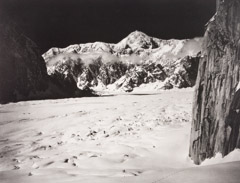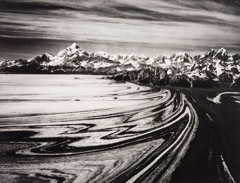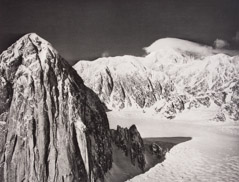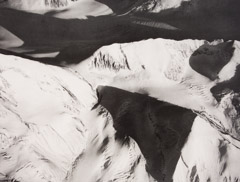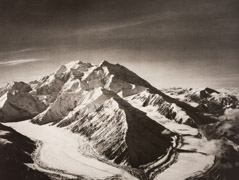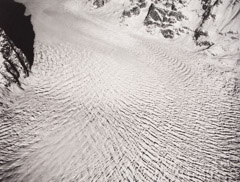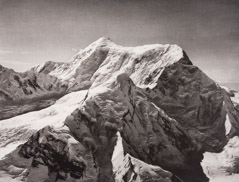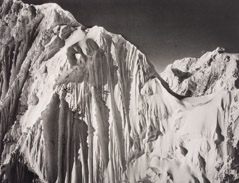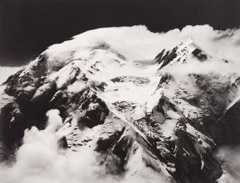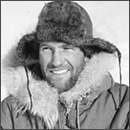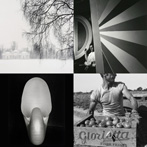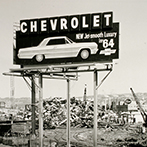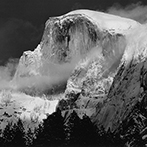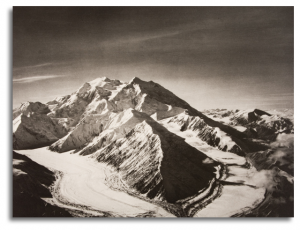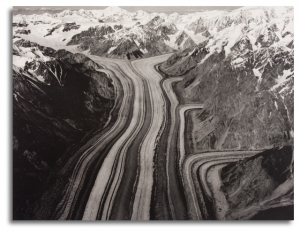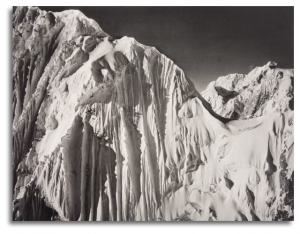Bradford Washburn
Bradford Washburn (1909 – 2007) was an explorer, geographer, mountaineer, cartographer and photographer.
The following text was published in Colin Well’s obituary of Washburn in The Independent in 2007: By the time he reached Harvard, he was already a climbing celebrity, inducted into the prestigious New York Explorer’s Club and a member of the French Alpine Club’s élite Groupe de Haute Montagne to boot, and helping to pay his college fees with the proceeds from lecturing about his adventures. Coming under the influence of Henry Hall, the President of the Harvard Mountaineering Club and an enthusiast for the exploration of the Canadian Rockies, Washburn began a campaign of exploratory mountaineering that would make him the foremost North American alpinist of the mid-20th century. He was especially drawn to the Yukon and Alaska: “I was just fascinated, this was a new place. Very few people had been there.” Starting as a fresh-faced sophomore in 1930 and ending as a grizzled veteran in 1955, Washburn would plan, organise, raise funds and execute numerous expeditions to the far north. They resulted in scores of first ascents of remote mountain giants and new routes including the famous West Buttress Route of North America’s highest peak, Denali/Mount McKinley in 1951. In the mid-1950s, however, Washburn effectively retired from major expeditions to concentrate on his career as the Director of the New England Museum of Natural History. He had been recruited aged 28; the youngest director ever appointed to a major US museum. Over the next 40 years he would transform it from an old-fashioned and ramshackle Victorian collection into the Boston Museum of Science, one of the leading institutions of its kind.
Washburn also greatly advanced the technique of aerial photography and mountain cartography during this period. Initially interested in gaining topographical information in order to help plan his exploratory mountaineering, he pioneered the use of large-format cameras, removing the side door from single-engine aeroplanes and lashing himself to the bulkhead with ropes along with a 50lb Fairchild F6 camera to avoid being sucked into thin air. Washburn’s pictures, however, transcended mere utilitarian purposes. Showing the influence of his friend Ansel Adams, the doyen of American landscape photographers, many of his large-format monochrome prints of mountains, beautifully composed and exposed and packed with spectacular detail, are now regarded as works of art. As with Washburn’s mountaineering, wider public recognition of this aspect of his work came late, with the photographic world becoming fully aware of his legacy in 1990 after Tony Decanaes “discovered” his 15,000-strong collection and began exhibiting Washburn’s pictures. Washburn’s achievements did not stop there, however. In between he managed to advance the cause of mountain cartography significantly, producing exceptionally detailed maps of, amongst other places, Denali, the Grand Canyon and Everest. Aged 89, he helped carry out research into the elevation of Everest that led to a more precise redefinition of its height. At the time of his death, he was working on a map of his retirement community in Lexington, Massachusetts. Despite his extraordinary achievements in mountaineering and photography, Washburn remained most proud of his work in science education. “The top of Mount McKinley was thrilling,” he said, “but there’s nothing on earth more exciting than the eyes of a youngster at the instant of discovery.”
All images: ©Bradford Washburn, courtesy DecaneasArchive.com
The work of Bradford Washburn is featured in these exhibitions.
(Select the image to view the exhibition page)
The work of Bradford Washburn is featured in these Theme Collections.
(Select the image to view the theme page)
Bradford Washburn - Renaissance Man
Bradford Washburn was truly an American version of a 20th century Renaissance man. Cartographer, scientist, esteemed climber and explorer, museum director, and photographer were some of the pursuits at which he excelled. Among his many activities, Washburn spent 60 years making stunning aerial photographs of frozen vistas, most notably in Alaska.READ ENTIRE ARTICLE
All images: ©Bradford Washburn, courtesy DecaneasArchive.com


